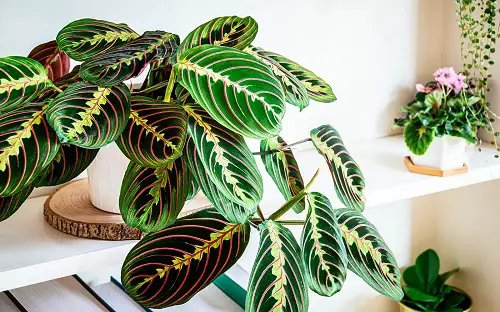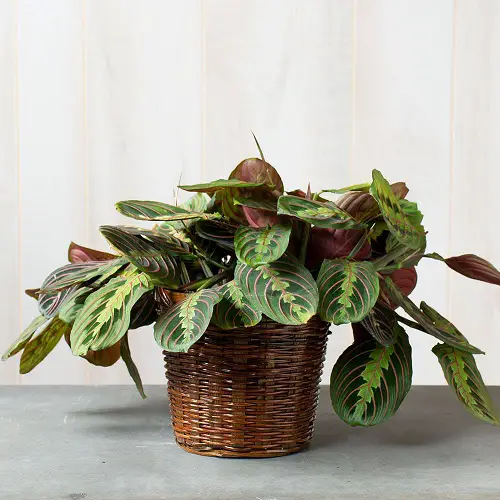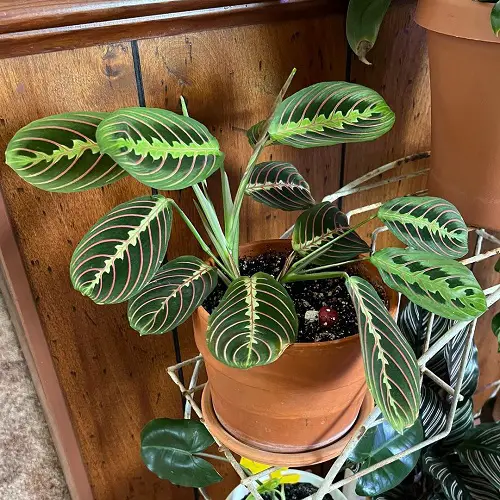Worried About your Prayer Plant Leaves Curling? Check out the Reasons and Solutions with expert tips mentioned in this comprehensive guide.
Prayer Plant Leaves Curling can indicate various issues it might be going through. Let’s have a look at them in detail.
Check out the Most Beautiful Types of Prayer Plants
Prayer Plant Information
Prayer plants (Maranta leuconeura) are a popular choice for tropical houseplants due to their vibrant and colorful foliage. They are easy to care for and thrive in low-light environments.
Note: It’s important to note that new leaves on a prayer plant are typically curled when they emerge, and they will unfurl and mature over time. Before worrying about curled leaves, it’s best to confirm that they aren’t simply new growth. However, if you observe mature leaves curling inward from the edges, this could indicate a problem worth investigating.
Are Prayer Plants Toxic to Dogs? Find Out
Prayer Plant Leaves Curling: Reasons and Solutions
1. Lack of Sunlight

Sunlight plays a crucial role in a plant’s development, which can be a major factor behind Prayer Plant Leaves Curling.
While prayer-plants can thrive in low-light conditions, they still require some exposure to sunlight to survive. For optimal growth, these plants prefer to be in an area with bright to medium indirect light. Lack of sunlight is a definite reason behind Prayer Plant Leaves Curling.
In such cases, it is possible that inadequate lighting is the issue.
- To address this, consider relocating your plant to a brighter spot (without direct sunlight) or placing a grow light in close proximity if natural light cannot be increased.
- Remember that although prayer-plants can tolerate low-light environments, their growth may be stunted in such conditions.
2. Underwatering
Prayer plants grow well in consistently moist soil. If the soil dries out too much between waterings, the leaves may begin to curl, and the plant may display drooping, soft, and limp leaves if it’s underwatered.
- To resolve this issue, you should water the plant thoroughly and be sure to maintain a regular watering schedule.
- Water the plant only when the top soil feels a little dry to the touch.
3. Lack of Humidity

Prayer plants can survive in standard household humidity levels, but they thrive best in a humidity level of at least 50%. On average, standard household humidity levels usually range from 30-50%.
However, if you’ve placed your prayer plant in an area of your home with particularly dry air, such as near a heater or drafty vent, its leaves may start to curl due to the lack of humidity.
- Purchase a small humidifier designed specifically for plants and place it near the plant. These humidifiers are usually compact, stylish, and discreet enough to blend in with any décor.
- You can also increase humidity by using a pebble tray. Simply fill a shallow tray with pebbles and water and place the plant pot on top of the pebbles. As the water evaporates, it will add moisture to the air around the plant. Be sure to refill the tray as necessary to maintain the humidity level.
4. Temperature
Although rare, extreme temperatures can also be the reason behind Prayer Plant Leaves Curling. These plants prefer a tropical climate and thrive in temperatures ranging from 60 to 80 degrees Fahrenheit (15 to 27 degrees Celsius), which are commonly found indoors.
5. Poor Water Quality

Over time, the ions and minerals present in the water used to irrigate plants can accumulate in the soil.
As the concentration of these solid particles increases, they can attach themselves to the plant roots in the form of salts, which can inhibit water absorption from the soil. This can cause the leaves to turn brown, curl, and even suffer from burns.
If tap water is the culprit behind your plant’s curled leaves, it is advisable to switch to distilled water, which can help restore the plant’s health. You can also use rainwater for this purpose.
6. Root Bound
When a plant outgrows its container, it can become root-bound, which means its root system becomes tangled and may grow out of the soil.
This can lead to several symptoms in the plant, such as frequent wilting, stunted growth, smaller new leaves, and yellowing or curling of leaves.
- Re-potting it into a one-size bigger container can be a good option.
- This will allow the plant to spread its roots and have more room to expand, which can potentially help it grow bigger and faster.
7. Pest Issues
Plants can be negatively affected by various pests, with the most frequent ones being scale, mealy bugs, and root mealy bugs.
These pests extract plant fluids from the leaves, which can cause the plants to become weak and develop wrinkles, as well as curl or bend. Additionally, there are less common pests, such as spider mites and fungus gnats, that can also cause harm to plants.
Neem oil can be applied through foliar spraying, and after a few treatments, it has proven to be effective against all of these pests.
Check out Pictures of Maranta Houseplant on Instagram


